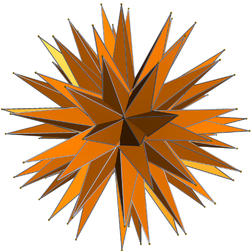Great_pentagrammic_hexecontahedron
Great pentagrammic hexecontahedron
Polyhedron with 60 faces
In geometry, the great pentagrammic hexecontahedron (or great dentoid ditriacontahedron) is a nonconvex isohedral polyhedron. It is the dual of the great retrosnub icosidodecahedron. Its 60 faces are irregular pentagrams.

| Great pentagrammic hexecontahedron | |
|---|---|
 | |
| Type | Star polyhedron |
| Face | |
| Elements | F = 60, E = 150 V = 92 (χ = 2) |
| Symmetry group | I, [5,3]+, 532 |
| Index references | DU74 |
| dual polyhedron | Great retrosnub icosidodecahedron |








